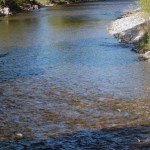Drought is the climatological phenomenon that dares not speak its name, it seems.
"There’s a lot of different definitions of drought, so a lot of people in government don’t like to use the word," says Anna Warwick Sears, Executive Director of the Okanagan Basin Water Board.
"In fact, (provincial government) employees weren’t allowed to use the word in 2003," Kelowna’s Firestorm year, Sears says.
"Usually we like to talk about water shortages, because drought’s like such a hot-button issue."
Sears recently addressed Kelowna council on drought preparedness and other water-related topics, and expanded on them later with Castanet News.
So how does she characterize the Okanagan’s current extended dry spell and developing water shortages?
"I don’t like to use the d-word either," Sears says.
"I would say that there is cause for concern about water shortages in the Okanagan at different water utilities this year."
Wikipedia describes drought as an extended period of months or years when a region notes a deficiency in its water supply.
B.C. Ministry of Environment data suggests that the Okanagan is in its 18th consecutive month of below-normal flow into Okanagan Lake.
The Okanagan’s overall preparedness for drought is "a bit patchy," says Sears.
Sears is busy planning a drought preparedness workshop for the Okanagan’s municipalities and water utilities that will allow them to assess where they’re at and where they need to go.
With OBWB approval being sought for the workshop at its upcoming meeting Tuesday in Vernon, the meeting likely will be held in a couple of weeks.
So how does society prepare for a drought? "Good question," Sears comments.
"Part of the way you plan for drought is to ensure that (individual) water utilities have their own plans in place, so they can deal with individual water shortages."
OBWB research has found that some utilities do not have their own formal drought plans in place, and the plans of some that do are inadequate, says Sears.

